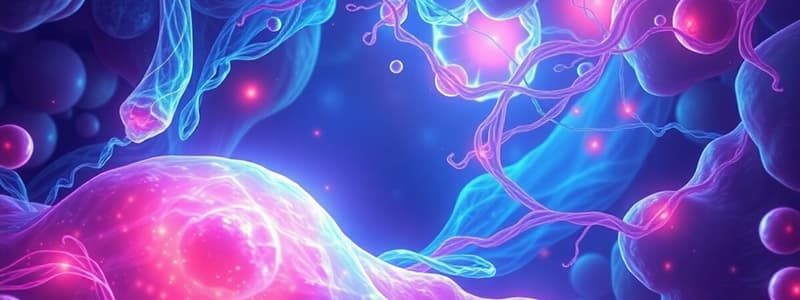Podcast
Questions and Answers
What occurs when malignant cells cross the basal lamina?
What occurs when malignant cells cross the basal lamina?
- The tumor classification is upgraded to a more dangerous level. (correct)
- The tumor classification is downgraded to a less dangerous level.
- The tumor becomes benign and poses no threat.
- The tumor classification remains unchanged.
Which type of epithelium is primarily involved in the secretion of hormones directly into the bloodstream?
Which type of epithelium is primarily involved in the secretion of hormones directly into the bloodstream?
- Exocrine epithelium
- Glandular epithelium (correct)
- Ciliated epithelium
- Basal epithelium
What defines Victorian Transport across epithelial tissues?
What defines Victorian Transport across epithelial tissues?
- It consists of transport occurring exclusively at the basal membrane.
- It involves transport that occurs only via passive diffusion.
- It is a random process without specific directional flow.
- It requires active transport on one side of the cellular sheet and different transport on the other side. (correct)
Which transporters are mainly involved in the efflux transport in epithelial cells?
Which transporters are mainly involved in the efflux transport in epithelial cells?
Which of the following locations does Victorian Transport NOT occur?
Which of the following locations does Victorian Transport NOT occur?
What role do solute carrier (SLC) transporters primarily play?
What role do solute carrier (SLC) transporters primarily play?
What is a primary characteristic of the epithelial cells involved in Victorian Transport?
What is a primary characteristic of the epithelial cells involved in Victorian Transport?
What is the primary component of mucous connective tissue?
What is the primary component of mucous connective tissue?
Which connective tissue type is known to mainly consist of mesenchymal cells?
Which connective tissue type is known to mainly consist of mesenchymal cells?
Where is loose areolar connective tissue primarily found?
Where is loose areolar connective tissue primarily found?
What is a significant feature of mesenchymal connective tissue observed in adults?
What is a significant feature of mesenchymal connective tissue observed in adults?
Which type of connective tissue is characterized by a loose arrangement of fibers and high tissue fluid content?
Which type of connective tissue is characterized by a loose arrangement of fibers and high tissue fluid content?
What contributes to the toxicity risk when drugs are administered with P-Glycoprotein inhibitors?
What contributes to the toxicity risk when drugs are administered with P-Glycoprotein inhibitors?
Why do smaller molecules tend to be absorbed more readily in the body?
Why do smaller molecules tend to be absorbed more readily in the body?
Under what conditions are weak acids more readily absorbed in the gastrointestinal tract?
Under what conditions are weak acids more readily absorbed in the gastrointestinal tract?
What mechanism does Ezetimibe utilize to lower cholesterol absorption?
What mechanism does Ezetimibe utilize to lower cholesterol absorption?
Which factor significantly impacts the degree of drug ionization in the body?
Which factor significantly impacts the degree of drug ionization in the body?
How do weak bases behave in relation to pH levels in the body?
How do weak bases behave in relation to pH levels in the body?
Which condition enhances the absorption of acetaminophen?
Which condition enhances the absorption of acetaminophen?
What effect do Gliflozins have on blood glucose levels?
What effect do Gliflozins have on blood glucose levels?
Which of the following characteristics is typical of lipid-soluble drugs compared to water-soluble drugs?
Which of the following characteristics is typical of lipid-soluble drugs compared to water-soluble drugs?
What is the primary role of macrophages in the immune system?
What is the primary role of macrophages in the immune system?
How do T lymphocytes differ from B lymphocytes in terms of maturation?
How do T lymphocytes differ from B lymphocytes in terms of maturation?
What percentage of circulating lymphocytes are B cells?
What percentage of circulating lymphocytes are B cells?
What is the main function of memory cells in the immune system?
What is the main function of memory cells in the immune system?
What distinguishes null cells from other lymphocyte subtypes?
What distinguishes null cells from other lymphocyte subtypes?
What is a defining characteristic of effector cells in the immune response?
What is a defining characteristic of effector cells in the immune response?
Which statement correctly identifies a role of cytokines in the immune response?
Which statement correctly identifies a role of cytokines in the immune response?
Where do lymphocytes primarily become immunologically competent?
Where do lymphocytes primarily become immunologically competent?
After maturation, what differentiates the cells of a specific lymphocyte clone?
After maturation, what differentiates the cells of a specific lymphocyte clone?
What is a significant aspect of the life span of T and B cells?
What is a significant aspect of the life span of T and B cells?
Which type of cell is primarily responsible for the first line of defense against bacterial infection?
Which type of cell is primarily responsible for the first line of defense against bacterial infection?
What characteristic feature distinguishes eosinophils from other white blood cells?
What characteristic feature distinguishes eosinophils from other white blood cells?
Which substance is released by basophils during an allergic reaction?
Which substance is released by basophils during an allergic reaction?
The presence of which structure in females' neutrophils is characteristic for sex identification?
The presence of which structure in females' neutrophils is characteristic for sex identification?
What happens to neutrophils after they perform their function?
What happens to neutrophils after they perform their function?
Which blood cell type is known to become macrophages after migrating into connective tissue?
Which blood cell type is known to become macrophages after migrating into connective tissue?
What physiological effect can occur due to the release of histamine by basophils during an allergic reaction?
What physiological effect can occur due to the release of histamine by basophils during an allergic reaction?
What role do corticosteroids play in the regulation of eosinophil levels?
What role do corticosteroids play in the regulation of eosinophil levels?
What is a defining feature of basophils compared to other leukocytes?
What is a defining feature of basophils compared to other leukocytes?
What is the primary function of eosinophils in the immune response?
What is the primary function of eosinophils in the immune response?
Flashcards
Victorian Transport
Victorian Transport
A process of transporting a substance across a whole layer of epithelial cells, involving active transport on one side and diffusion or facilitated diffusion on the other.
Glandular Epithelium
Glandular Epithelium
A type of epithelium found in glands, which are categorized into exocrine (secreting via ducts) and endocrine (secreting directly into circulation).
Transport Across the Cell Membrane
Transport Across the Cell Membrane
Molecules cross the phospholipid bilayer of a cell membrane using various transport mechanisms.
Basal Lamina
Basal Lamina
Signup and view all the flashcards
ATP-binding Cassette (ABC) Superfamily
ATP-binding Cassette (ABC) Superfamily
Signup and view all the flashcards
Solute Carrier (SLC) Superfamily
Solute Carrier (SLC) Superfamily
Signup and view all the flashcards
Transcellular Transport
Transcellular Transport
Signup and view all the flashcards
Drug Absorption
Drug Absorption
Signup and view all the flashcards
Drug Ionization & Absorption
Drug Ionization & Absorption
Signup and view all the flashcards
pKa of a Drug
pKa of a Drug
Signup and view all the flashcards
Absorption of Weak Acids
Absorption of Weak Acids
Signup and view all the flashcards
Absorption of Weak Bases
Absorption of Weak Bases
Signup and view all the flashcards
Ezetimibe
Ezetimibe
Signup and view all the flashcards
Gliflozins (Sodium-Glucose Co-transporter-2 Inhibitors)
Gliflozins (Sodium-Glucose Co-transporter-2 Inhibitors)
Signup and view all the flashcards
Victorian Transport by Drugs
Victorian Transport by Drugs
Signup and view all the flashcards
Concomitant Inhibitors of P-Gp
Concomitant Inhibitors of P-Gp
Signup and view all the flashcards
Neutrophil
Neutrophil
Signup and view all the flashcards
Eosinophil
Eosinophil
Signup and view all the flashcards
Basophil
Basophil
Signup and view all the flashcards
Monocyte
Monocyte
Signup and view all the flashcards
Phagocytosis (Neutrophils)
Phagocytosis (Neutrophils)
Signup and view all the flashcards
Phagocytosis (Eosinophils)
Phagocytosis (Eosinophils)
Signup and view all the flashcards
Basophil Granule Degranulation
Basophil Granule Degranulation
Signup and view all the flashcards
Anaphylactic Shock
Anaphylactic Shock
Signup and view all the flashcards
Monocyte Differentiation
Monocyte Differentiation
Signup and view all the flashcards
Mononuclear Phagocytic System
Mononuclear Phagocytic System
Signup and view all the flashcards
What are macrophages?
What are macrophages?
Signup and view all the flashcards
What do macrophages produce?
What do macrophages produce?
Signup and view all the flashcards
How do macrophages present antigens?
How do macrophages present antigens?
Signup and view all the flashcards
What are lymphocytes?
What are lymphocytes?
Signup and view all the flashcards
What do B lymphocytes do?
What do B lymphocytes do?
Signup and view all the flashcards
What do T lymphocytes do?
What do T lymphocytes do?
Signup and view all the flashcards
What are null cells?
What are null cells?
Signup and view all the flashcards
What are memory cells?
What are memory cells?
Signup and view all the flashcards
What are effector cells?
What are effector cells?
Signup and view all the flashcards
What is immunological competence?
What is immunological competence?
Signup and view all the flashcards
Mesenchymal Connective Tissue
Mesenchymal Connective Tissue
Signup and view all the flashcards
Mucous Connective Tissue
Mucous Connective Tissue
Signup and view all the flashcards
Loose Areolar Connective Tissue
Loose Areolar Connective Tissue
Signup and view all the flashcards
Dense Regular Connective Tissue
Dense Regular Connective Tissue
Signup and view all the flashcards
Dense Irregular Connective Tissue
Dense Irregular Connective Tissue
Signup and view all the flashcards
Study Notes
Innate Immunity
- Innate immunity is an immediate, non-specific response to pathogens.
- It doesn't confer long-lasting immunity.
- The response occurs in three phases: early induced responses, adaptive immune response, and removal of the infectious agent.
- Cells of innate immunity include neutrophils, monocytes, macrophages, natural killer (NK) cells, eosinophils, and basophils.
Adaptive Immunity
- Adaptive immunity is specific, has immunologic memory, and responds rapidly to a second antigen exposure.
- It involves two main types: active and passive immunity.
- Active immunity: the body's own response to foreign material.
- Active natural immunity: immunity developed through exposure to foreign Ags.
- Active artificial immunity: immunity conferred through the introduction of vaccines.
- Passive immunity: the body receives preformed antibodies.
- Passive natural immunity: antibodies transferred from mother to the fetus.
- Passive artificial immunity: the administration of preformed antibodies.
- Cells involved include macrophages and lymphocytes (B and T cells).
- B-cells: involved in antibody-mediated immunity.
- T-cells: involved in cell-mediated immunity.
Components of Adaptive Immunity
- Macrophages: antigen presenting cells.
- B-cells: mature in the bone marrow, express IgM immunoglobulin receptors (BCRs)
- T-cell-dependent activation: involves T-cells for full B-cell response; activation results in antibody production.
- T-cell-independent activation: does not require T-cell support.
- T-cells:
- CD4-positive T-cells: regulate B-cell activation and function.
- CD8-positive T-cells: destroy infected or cancerous cells (cytotoxic T lymphocytes).
- T-regulatory cells (T(regs)): suppress the immune response.
Immune Cells
- Neutrophils: the first responders to infection; phagocytosis.
- Monocytes/Macrophages: phagocytosis, cytokine production, and antigen presentation.
- Natural Killer (NK) cells: identify and kill infected or cancerous cells.
- Eosinophils and Basophils: involved in allergic reactions and defense against parasites.
- Lymphocytes (B and T cells): responsible for the adaptive immune response.
Cytokines
- Cytokines are proteins involved in communication between cells during the immune response.
- Types include interleukins (ILs), colony-stimulating factors (CSFs), tumor necrosis factors (TNFs), transforming growth factors (TGFs), and interferons (IFNs).
Complement System
- The complement system is a collection of proteins in blood serum that work together to enhance the immune response.
- Activation occurs through three pathways: classical, alternative, and lectin pathways.
- The result of the pathways is to form a membrane attack complex (MAC) leading to cell lysis.
Major Histocompatibility Complex (MHC)
- The MHC is a set of polymorphic genes on chromosome 6.
- MHC Class I molecules are expressed on nearly all nucleated cells.
- MHC Class II molecules are expressed mainly on antigen-presenting cells (APCs).
- They are involved in the presentation of antigens to T cells, enabling pathogen recognition and killing.
Immunodeficiency Diseases
- Primary immunodeficiencies: genetic defects in immune cells/proteins.
- Secondary immunodeficiencies: acquired impairments due to other factors like infections, malignancy, or drugs.
- Defects can affect phagocytes, B cells, T cells, or complement proteins.
Types Of Hypersensitivity Reactions
- Type I: immediate hypersensitivity (allergy); mediated by IgE, mast cells, and basophils leading to the release of inflammatory mediators.
- Example: anaphylaxis, allergies, asthma.
- Type II: cytotoxic hypersensitivity; antibody-mediated destruction or dysfunction of cells.
- Example: blood transfusion reactions, hemolytic disease of the newborn.
- Type III: immune complex-mediated hypersensitivity; immune complexes deposit in tissues, triggering inflammation.
- Example: lupus, rheumatoid arthritis.
- Type IV: delayed hypersensitivity; cell-mediated response, T cells, and cytokines leading to tissue damage.
- Example: contact dermatitis, transplant rejection.
Studying That Suits You
Use AI to generate personalized quizzes and flashcards to suit your learning preferences.





